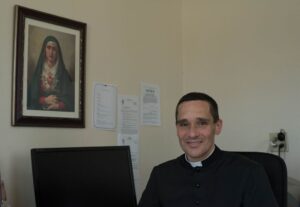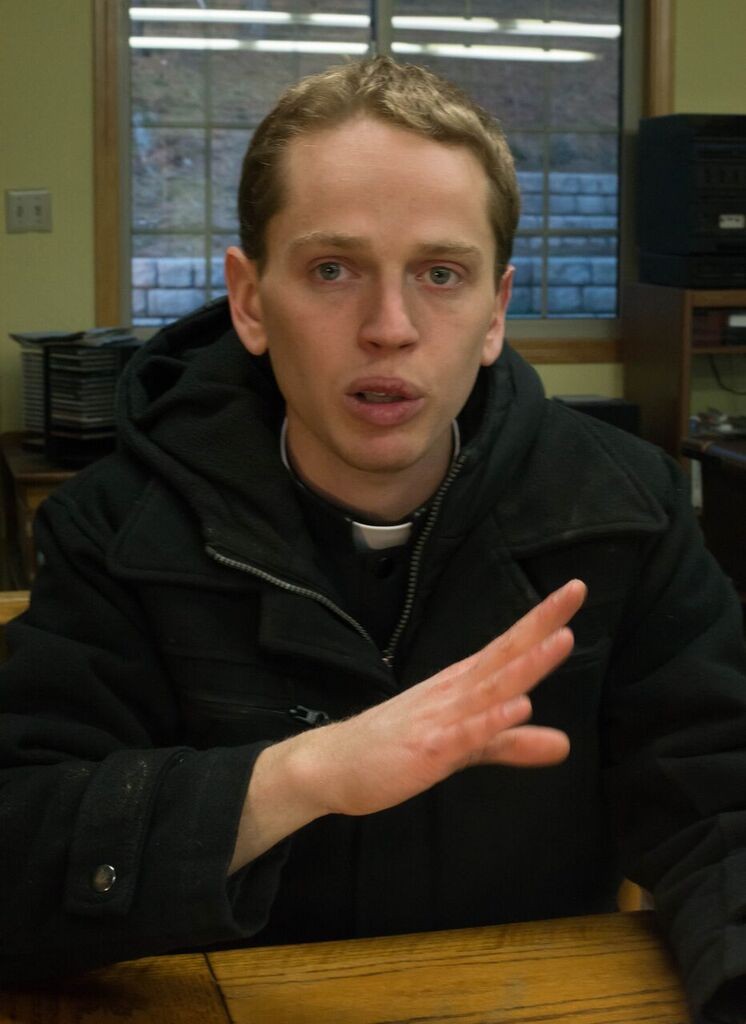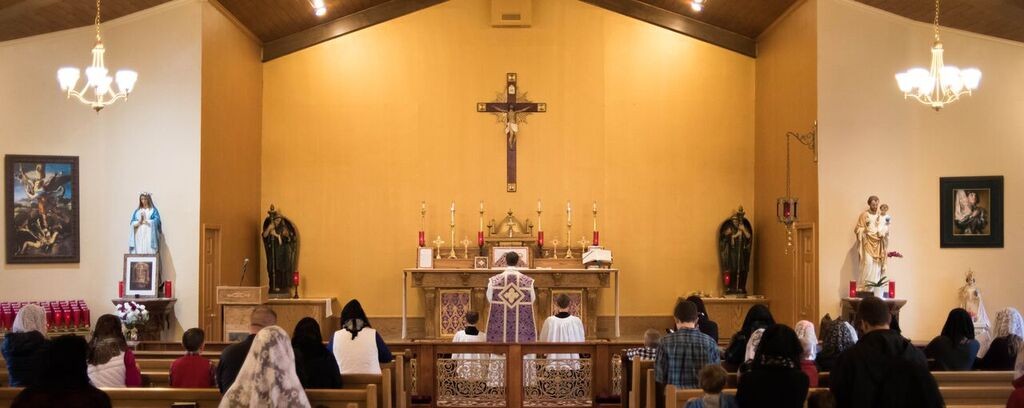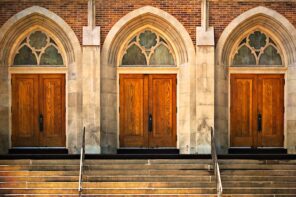Last December, at the end of his tour of Africa, Pope Francis answered a question about Islamic fundamentalism by pointing to the same malady in his own flock.
“We Catholics have some—and not some, many—who believe they possess the absolute truth and go ahead dirtying the other with calumny, with disinformation, and doing evil. They do evil. I say this because it is my Church.”
He didn’t name names, but for some, it was hard not to take it personally.
Father Dennis Gordon, for one, pastor of the St. Joan of Arc in Coeur d’Alene, Idaho, says that “a lot of traditionalists took it that he was talking about them,” allowing himself a smile.
Seated in his modest parish office, resplendent in a traditional black Roman cassock, Gordon worried that the remarks might make his job, and that of his order—“to be a bridge between traditionalists and the Church”—a little bit harder.
Anything that upsets traditional Catholics is bound to have a particular resonance in his location, in the north Idaho-Washington borderland, where a decades-old resistance to modern Catholicism and the new Mass is continuing, and even growing.
“All sides claim that more Catholics every year are moving here to be a part of a form of Catholic life that most of the Church left behind half a century ago.”
Along just 35 miles of U.S. Highway 90, between Spokane and the well-kept, lakeside tourist town of Coeur d’Alene, there are more than 3,000 people attending Latin Mass each week. Among them we can see the full spectrum of lasting reactions to the modernizing reforms of Vatican II, including the new Mass.
Father Gordon and his Fraternal Society of St. Peter (FSSP) are offering the area’s only Latin Masses that have the approval of the Bishop, but only a minority of the county’s Latin Massgoers are attending St. Joan of Arc. Most attend the Immaculate Conception in Post Falls and the other nearby chapels served by the Society of St. Pius X (SSPX), a priestly fraternity whose founder ran afoul of the Vatican in the 1970s and whose members—although ordained— do not have official permission from the Church to engage in priestly duties.
The balance of those attending Mass mostly do so under the auspices of the Congregation of Mary Immaculate Queen (CMRI). This group is openly schismatic, and claims that the Pope’s throne has been vacant since the “heretical” excesses of Vatican II and the introduction of the new Mass. The CMRI ministers to hundreds who believe that this “sedevacantist” (literally: “empty seat”) remnant is in fact the one true church.
The SSPX and the CMRI not only offer Mass, but run schools and seminaries, minister to associated traditionalist convents, and generally offer a whole way of life in which the faithful can immerse themselves.
All sides claim that more Catholics every year are moving here to be a part of a form of Catholic life that most of the Church left behind half a century ago. This is evident in imagery and forms of devotion—largely Marian—that the mainstream Church has given far less emphasis to in recent decades.
On entering a traditionalist church like St. Joan of Arc, older Catholics might be instantly transported to the experiences of youth. For better or worse, Generation X and Y Catholics may—as I did—receive an uncanny reminder of the holy pictures, crucifixes and rosary-centered piety possessed by their grandparents.
“Northern Idaho is a stronghold of conservative Christians of all denominations. It has long been a target of migration by those who, as local realtor Chris Watson puts it, ‘are looking for the 1950s in the 2010s.’”
So how did this corner of the inland Pacific Northwest become a bulwark for a frankly anti-modern form of Catholicism?
Part of the answer has to do with Idaho. Bernard Doherty, a religious studies scholar at Australia’s St. Mark’s National Theology Center who has researched traditional Catholicism extensively, says that throughout the world, the Latin Mass subculture “grows in particular areas, usually though not exclusively, rural areas, and often those with a particular demographic makeup and history of more conservative strands of religious practice.”
Conservative Catholics, like other religious conservatives, may “seek what they feel is a refuge from aspects of modernity, which is better achieved amongst a supportive community and in a less urban environment.”
Northern Idaho fits the bill on both counts. Apart from the modest amount of provincial sprawl around Coeur d’Alene, what isn’t given over to public land is all farmland and acreage. It is one of the least populated parts of a state that has the seventh lowest population density in the country. Coeur d’Alene is a seven-hour drive from the Cathedral in Boise. Geographical isolation from church authority may be a factor in allowing cultural divergence from mainstream Catholicism.
Northern Idaho is a stronghold of conservative Christians of all denominations. It has long been a target of migration by those who, as local realtor Chris Watson puts it, “are looking for the 1950s in the 2010s.” He says people come here seeking like minds, distance from liberal America, and looser restrictions on guns, home-schooling, religious freedom and property rights.
“He did think it possible that traditionalist breakaway groups could unite as a single congregation. Speaking of the SSPX, he says that ‘We have much more in common with each other than we do with that guy in Rome.'”
Apart from the long-term attraction of Idaho, there’s the fact that this is one of the places where anti-modern traditional Catholicism got started.
First here was the Congregation of Mary Immaculate Queen, which was founded as an approved congregation in 1967 with the permission of the bishop of Spokane. Its originator was Francis Schuckardt, then a layman with a long history as a fervent organizer of Marian devotional groups.
As the reforms of Vatican II took hold, Schuckardt’s misgivings took a dramatic turn. He came to believe that the Council’s reforms contradicted the infallible pronouncements of previous popes, meaning that the Council itself as well as post-conciliar Popes were heretical—Peter’s throne was empty.
From here, it was only a short leap to Schuckardt’s claim that the CMRI was actually the last embattled remnant of the true Church. In 1968, he had himself consecrated as a bishop by the Old Catholic Church (which had itself split from Catholicism over doctrinal disagreements in the late 19th century). He then began attracting priests, religious and laypeople to his congregation, and to the region.
CMRI expanded around the world in the 1970s and 1980s, opening churches, seminaries and convents in Canada, Europe and Australia. But Schuckardt was ousted from the leadership of his own congregation in 1984 amid allegations of sexual impropriety and administrative incompetence. The CMRI moved its headquarters to Omaha, Nebraska, under a new bishop.
In many ways CMRI exhibits a pattern found in the more extreme traditionalist organizations: erratic leaders, improvised and dubious forms of ecclesiastical succession, an increasing isolation from the mainstream Church—and a hefty dose of conspiracy thinking to account for how post-conciliar Catholicism went so wrong.
I encountered all of this when I visited Rathdrum, Idaho for a chat with assistant pastor, Father Anthony Short.
Father Short is only 25, having gone straight from home-schooling under traditionalist parents into St. Joseph seminary in Rathdrum, and then into the major seminary in Omaha, from whence he returned to be deputy pastor.
He was sincere—even guileless—in conversation, not least in his explanation of the “Masonic infiltration of the Church,” whose first major success was the installation of John XXIII as pope.
“They wanted to get their man on the throne. They started infiltrating seminaries, they got enough people as bishops and then finally they went for the whole thing.”
Father Short held no hopes of being reconciled with the Church as it stood, but was more optimistic about uniting the various streams of Latin Mass Catholics.
“Realistically they’re not going to drop what they’ve accomplished. The fact of the matter is that they have left the Church.”
He did think that traditionalist breakaway groups might one day unite as a single congregation. Speaking of the SSPX, he offered, “We have much more in common with each other than we do with that guy in Rome.”
This view is not shared by the SSPX, the largest Latin Mass congregation in the area. Neither sedevacantist nor completely estranged from the Church, they remain in the peculiar in-between position they have occupied for years.
The organization was established by French Archbishop Marcel Lefebvre in 1970—as he became more and more alarmed by the implementation of Vatican II reforms, and the rollout of the New Mass by Paul VI.
“It’s possible that initially Church authorities thought that these people were just holdouts, who would soon give up or die off. The large number of young families I saw at St. Joan of Arc—around a third of the parish—suggest to me what others must have by now have realized: that this constituency is not going anywhere soon.”
Lefebvre’s views wove together theological, ecclesiastical and political conservatism. Though, like all traditionalist groups, the SSPX claims to be preserving the Church’s immemorial traditions, Doherty says this is a selective view. “In many respects they are really preserving the kind of Catholicism in which Archbishop Lefebvre was raised and imbibed at the French Seminary in Rome during the early 20th century.”
This brand of Catholicism was oriented towards contesting the legacy of the French Revolution, and in particular a perceived “dechristianization” of France—and Europe. At the level of the papacy, it resulted in a string of “anti-modernist encyclicals from Gregory XVI’s Mirari Vos (1832) onwards.” But it also meant that priests like Lefebvre were formed in a conservative, even reactionary milieu.
During the 1970s and 1980s Lefevbre was gradually estranged from Rome due to repeated conflict with popes, and his adherence to the Latin Mass and traditional doctrine. In 1988 he consecrated several bishops without papal approval, and he and the new SSPX bishops were excommunicated.
This excommunication was in place until after Lefebvre’s death in 1991. But it did not stop the SSPX from expanding, training more priests, ministering to more parishes, and maintaining its stance on Vatican II and the Mass.
Father Paul Vassal is the Prior of the Post Falls community, and he stresses that the SSPX is primarily a priestly order, and the fathers are not specifically trained to be parish priests.
Vassal is urbane, mid-40s and speaks with a heavy French accent. It took some doing to get him to sit down, and he admits that the order is media-shy due to a tendency on the part of reporters to “reduce matters of faith to sociology or politics.”
He steers clear of culture war topics: his concern is with faith and the Mass. He still speaks of a “crisis in the Church,” but expresses hope at the fact that figures in the Diocese of Boise are more “respectful and sympathetic” of traditionalism.
But the success of SSPX brings us to a final reason why so many have moved to be in an area where the Latin Mass is readily available, and where they can be immersed in traditional Catholic culture—one that hints at a certain degree of pastoral misjudgement by the Church over decades.
And that is the unique beauty of the liturgy, which until the separatist groups were provoked was the Church’s exclusive property.
I was raised in the Church, but I didn’t attend my first Latin Mass until I visited Idaho. I am 42 years old. Having done so, I find it difficult to disagree with Father Gordon, that there is something about this liturgy that powerfully invokes the mystery of faith.
The High Mass deploys incense, traditional garb and choral responses to engage all of the senses. And every Latin Mass is staged in a way that orients the entire congregation and the priest towards the transcendent. It is almost entirely unlike the new Mass with its greater focus on interaction, mutuality, community, and its consequent admission of more of the quotidian world into the act of worship.
For some of those who spent a lifetime committed to the Latin Mass, its absence in those dioceses most committed to reform must have been a sharp disappointment.
It’s possible that Church authorities thought that these people were just holdouts, who would soon give up or die off. The large number of young families I saw at St. Joan of Arc—around a third of the parish—suggest to me what others must have by now have realized: that this constituency is not going anywhere soon.
Perhaps mistakes were made by those bishops whose “reformist zeal won over their pastoral sense,” as Doherty puts it. Wherever the commitment to the new Mass led to an overenthusiastic attempt to get rid of the Latin Mass, breakaway groups were encouraged, and Catholics were driven into the arms of groups sometimes led by erratic personalities like Schuckardt—who held troubling views about race, penance, and conspiracy.
If Latin Mass Catholicism is—as Francis hinted—a kind of fundamentalism, the answer to it might lie in a redoubled commitment to liturgical pluralism. Rather than berating traditionalists, Doherty thinks, it would be best for “local bishops to encourage and foster devotional and liturgical alternatives to those which groups like SSPX and CMRI provide their members.”
As Father Gordon put it, “Since there seems to be room in the Church for a lot of different manners of worshipping and modes of expression, it’s nice when there is room for us too.”
CORRECTIONS: An earlier version of this article stated that Archbishop Marcel Lefebvre died in 2004. He died in 1991. It also described other members of SSPX being excommunicated along with Lefebvre and his bishops, but only Lefebvre and the bishops were explicitly recognized as excommunicated.









